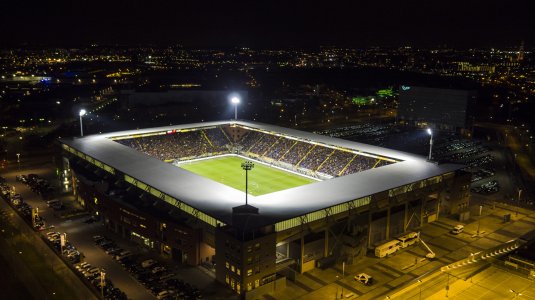StanAlekhin
Moderator
The Rat Verlegh Stadion, home to NAC Breda since its inauguration in 1996, is undergoing a significant renovation aimed at increasing its capacity and modernizing its facilities. Originally accommodating 19,000 spectators, the stadium's capacity is set to expand to approximately 20,500 seats.
The expansion focuses on enlarging the Eretribune and Hoofdtribune stands, adding between 1,500 to 1,600 new seats. These additions will cater to both commercial purposes and general public use. Additionally, the pitch will be lowered by 1.5 meters to enhance sightlines, and the turf will be upgraded. The dugouts are also slated for reconstruction. Beyond seating and pitch improvements, the stadium's commercial spaces will undergo renovations to better serve fans and stakeholders.
This project is part of NAC Breda's broader strategy to achieve financial independence and ensure a sustainable future. The club aims for a structural turnover growth exceeding €20 million, emphasizing the importance of modern infrastructure in achieving this goal.
Architectural Background
The original design of the Rat Verlegh Stadion was crafted by Bureau Bollen, with construction completed in 1996. The stadium was initially named FUJIFILM Stadion, later becoming MyCom Stadion, before adopting its current name in honor of Antoon 'Rat' Verlegh, a legendary figure in NAC Breda's history.

Image: Nac Breda official website - https://www.nac.nl/rat-verlegh-stadion
The expansion focuses on enlarging the Eretribune and Hoofdtribune stands, adding between 1,500 to 1,600 new seats. These additions will cater to both commercial purposes and general public use. Additionally, the pitch will be lowered by 1.5 meters to enhance sightlines, and the turf will be upgraded. The dugouts are also slated for reconstruction. Beyond seating and pitch improvements, the stadium's commercial spaces will undergo renovations to better serve fans and stakeholders.
This project is part of NAC Breda's broader strategy to achieve financial independence and ensure a sustainable future. The club aims for a structural turnover growth exceeding €20 million, emphasizing the importance of modern infrastructure in achieving this goal.
Architectural Background
The original design of the Rat Verlegh Stadion was crafted by Bureau Bollen, with construction completed in 1996. The stadium was initially named FUJIFILM Stadion, later becoming MyCom Stadion, before adopting its current name in honor of Antoon 'Rat' Verlegh, a legendary figure in NAC Breda's history.

Image: Nac Breda official website - https://www.nac.nl/rat-verlegh-stadion
Last edited: